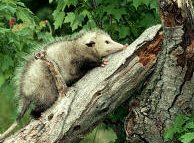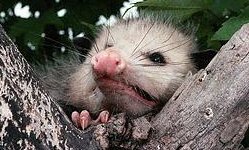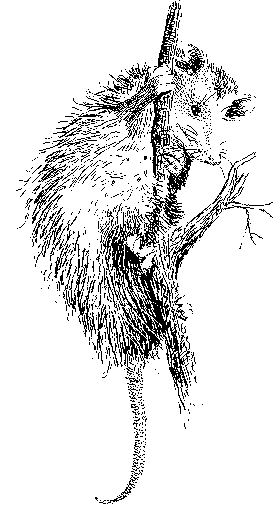|
|
Opossum Opossums, or possums, are the smallest and the stupidest of American terrier quarry. A possum will normally weigh between three and eight pounds, and the brain case of the animal is so small that the skull has a prominent bone ridge whose sole purpose is to give the possum a large enough cranial surface area for the jaw muscles to attach to. Rat-like in appearance, the typical possum has long, coarse, grayish-white fur, with a scaly prehensile tale, and sharp and slender muzzle, pink nose and black eyes. Possums are unique creature in many respects. They are north America's only marsupial or "pouch breeder" and they posses more teeth (50) than any other mammal in North America. The hind foot of a possum has four claw-bearing toes and a thumb-like opposable "big toe" which is clawless. The result is an odd looking track -- almost Martian-like in appearance. The opossums original range was from from Costa Rica north through Mexico and the central and eastern half of the United States to southeastern Canada. During the 1900s, its range expanded northward and westward. Its northem distribution is limited by winter temperatures and its westem distribution is limited by dry, hot climates. The opossum has been introduced along the Pacific Coast and is currently found from southern Califomia to southwestern British Columbia.
In many ways, possums are cursed animals. Not only do they have small brains, they are not very fast, and are easily killed by coyotes, farm dogs, fox and owls. The possum's competitive edge is in the reproduction arena, and here it is a true champion. A typical female possum will have two litters a year, each with as many as 18 young. The gestation period for a possum is just 13 days -- the shortest gestation period of any furbearer in North America. Pouch mortality is fairly high, and usually only five to eight baby possums survive to peek out in the world two months after being born. Young possums remain with their mother for 3 to 4 weeks after leaving the pouch. It is during this period that you often see them traveling on the backs of their mother, clinging on for dear life, but rarely falling off. Young possums are weaned at two and half months of age, and are independent at three and a half. Female opossums are sexually mature by 6 to 7 months of age; males by 8 to 9 months. Most possums die within the first 9 months of life, and few make it to age three. Opossum skull, side and from top. Opossums are active throughout the year, but may hole up in groundhog dens or hollow trees during cold periods. Possums are primarily nocturnal and will seek protective cover during the day. These shelter sites may include hollow trees, firewood racks, brush piles, groundhog burrows, and crawl spaces under houses and outbuildings. Opossums are omnivorous, eating a wide variety of foods but preferring animal matter -- grasshoppers, crickets, frogs and toads, small snakes, baby mice, and road-kill. Other main food crops include blackberries, pokeberries, wild grapes, and persimmons. Possums do not appear to have territories -- they simply wander around living a catch-as-catch can life, as short and as grim as it too often is. To see several very large possums, go to: www.terrierman.com/bosshog.htm
|

 Opossums prefer low,
damp, wooded streams and swamps. Farming areas having
hedgerows and small, wooded streams are preferred
over densely forested upland areas.
Opossums prefer low,
damp, wooded streams and swamps. Farming areas having
hedgerows and small, wooded streams are preferred
over densely forested upland areas. 